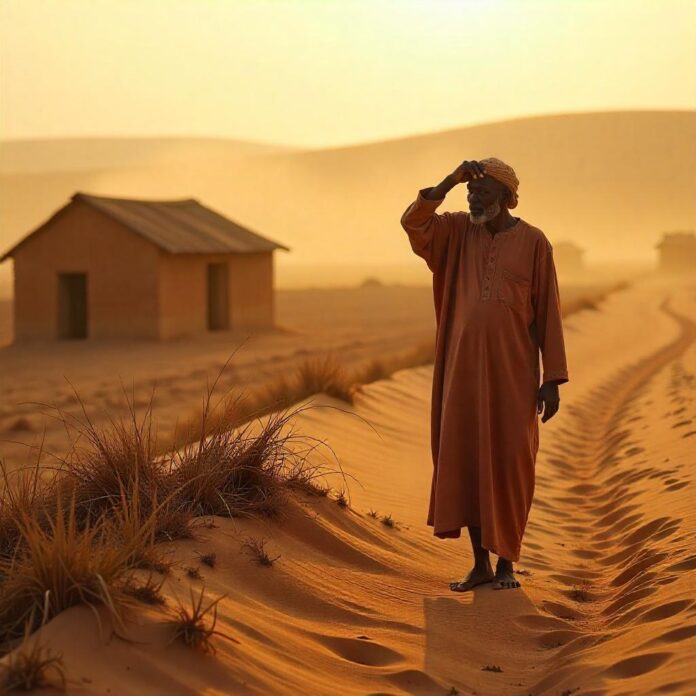Bulama Mele, a 40-year-old farmer in Yobe State, now treks daily to farm in Niger after watching Sahara’s sands swallow his ancestral Nigerian farmland. Without help, we will continue to suffer, he explains—a quiet witness to a crisis engulfing millions. Northern Nigeria loses 5km of agricultural land annually to wind-driven desertification, with the Sahara advancing southward at 0.6km per year. That’s equivalent to losing farmland larger than Lagos every five years. Today, 35% of Nigeria’s land is degraded, directly threatening food security for 62 million northern residents. As sands shift, so do lives—crops wither, villages vanish, and futures blow away with the Harmattan winds.
The Invisible Thief: Wind Erosion’s Brutal Mechanics
Picture the Harmattan—a dry, dusty wind sweeping across the Sahel. Now imagine it acting like sandpaper on skin, but against exposed topsoil. With 3.5% annual deforestation, the world’s highest rate, Northern Nigeria has lost its natural windbreaks. Trees that once anchored soil are gone, replaced by loose sediment that gusts carry away. Each storm strips fertile loam, leaving behind coarse desert sand that retains 70% less water. The result? Once-productive farms now resemble beach dunes. In Sokoto, this has slashed millet and sorghum yields by 40%.
Climate’s Vicious Feedback Loop
Wind erosion doesn’t work alone. Rainfall has dropped 20% in two decades, shortening growing seasons from 150 to 120 days. Less rain means sparser grasses, whose roots once bound soil. As vegetation vanishes, the land reflects more heat, reducing atmospheric moisture—a cycle called desert-rainfall collapse. Villagers in Katsina now dig 15 meters deeper for water than a generation ago. Lake Chad’s 90% shrinkage since the 1960s eliminated buffer humidity, accelerating aridity in Borno and Yobe. This isn’t just bad weather. It’s climate change accelerating a human-made disaster.
Human Hand, Heavy Hand
We’ve fueled this crisis. 90% of Nigeria’s forests have vanished since 1960, largely for firewood—still the primary energy source for 75% of households. In Kano, tree cover fell 95% in 60 years. But deforestation is just one wound. Deep ploughing and monocropping exhaust soil nutrients, while unregulated boreholes drained aquifers—water tables in Kano and Katsina dropped 15 meters. Overgrazing compounds this: hooves compact soil, increasing runoff fivefold during rare rains.
Food Security in Freefall
Imagine harvesting 40% less food from the same land. That’s reality in Sokoto, where millet—a dietary staple—yields have plummeted. In 2023 alone, maize and rice yields fell 30% while sorghum production dropped 40%. Result? 43 million Nigerians now face acute hunger—many in once-fertile north. Livestock suffer equally: pasture loss and dehydration caused ₦200 billion ($250 million) in losses in 2023.
Societies Unraveling
Land loss breeds desperation. In Toshia, Yobe, 20+ homes vanished under dunes, burying generations of heritage. As sands advance, farmer-herder conflicts now account for 60% of clashes as pastoralists migrate south. 2.5 million Nigerians displaced since 2015 crowd into slums, straining cities. Economically, degradation wipes out $5.1 billion yearly from agricultural GDP—a hemorrhage Nigeria can’t sustain.
Turning the Tide, One Acre at a Time
Water Wisdom: In Jigawa, rainwater harvesting ponds and drip irrigation have slashed water use 60% while boosting yields. Agroforestry’s Rise: Women in Borno now plant Faidherbia albida—a nitrogen-fixing fertilizer tree—between crops. Roots rebuild soil; leaves provide fodder. Similar Ugandan programs saw 15% higher manure use by women farmers.
Community Power: The Real Green Wall
Change sprouts locally. In Kano, communities deploy Delphino machines to rapidly terrace degraded land, paired with free seeds. Yobe’s targeted tree-planting—with boreholes for saplings—has reduced dune mobility by 40% in pilot zones. Plant more trees—they are our only shield, urges farmer Dauda Maigari.
Governance That Anchors Soil
Land Tenure Reform: Insecure ownership discourages long-term care. Adopt Uganda’s model: 20-year stewardship certificates incentivize farmers to invest in soil. Energy Shift: Subsidize LPG and solar cookers to replace firewood. Nigeria’s 2024 fuel subsidy removal worsened deforestation—a misstep to correct.
Climate-Smart Agriculture: Non-Negotiable
Prioritize drought-resistant crops like cassava and sorghum over water-intensive rice. Enforce groundwater regulations—and fund aquifer recharge projects like Niger’s water banking.
Losing 5km of farmland yearly isn’t statistics—it’s stolen legacies. Without intervention, northern Nigeria could lose 50% of food production by 2050. Yet hope takes root: ACReSAL’s terraced hectares, Yobe’s nurseries, and women planting Faidherbia prove the land can heal. Winning requires immediate scaling of agroforestry and water harvesting, policy muscle to halt deforestation and secure tenure, and global solidarity for a crisis echoing across the Sahel. Bulama Mele’s children needn’t become climate refugees. As sands advance, so must we—with trees as shields, policy as tools, and unity as our compass. The desert gains ground only where we yield it.


